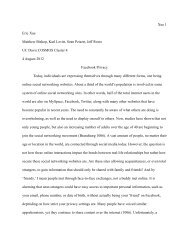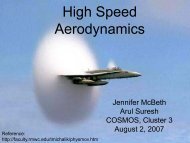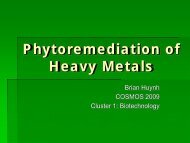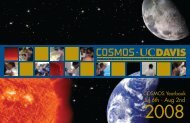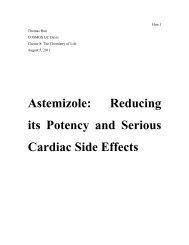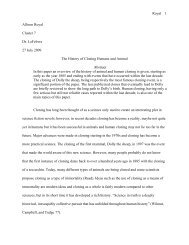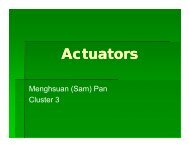Computing the Mass of Jupiter 1 - COSMOS - UC Davis
Computing the Mass of Jupiter 1 - COSMOS - UC Davis
Computing the Mass of Jupiter 1 - COSMOS - UC Davis
You also want an ePaper? Increase the reach of your titles
YUMPU automatically turns print PDFs into web optimized ePapers that Google loves.
<strong>Computing</strong> <strong>the</strong> <strong>Mass</strong> <strong>of</strong> <strong>Jupiter</strong> 1<br />
<strong>Computing</strong> <strong>the</strong> <strong>Mass</strong> <strong>of</strong> <strong>Jupiter</strong><br />
Based on <strong>the</strong> Orbit <strong>of</strong> <strong>Jupiter</strong>’s Four Main Moons<br />
Virginia Marcus<br />
<strong>COSMOS</strong> Cluster 9: Introduction to Astrophysics<br />
July 26, 2009
<strong>Computing</strong> <strong>the</strong> <strong>Mass</strong> <strong>of</strong> <strong>Jupiter</strong> 2<br />
Abstract<br />
I attempted to find <strong>the</strong> mass <strong>of</strong> <strong>Jupiter</strong> based on <strong>the</strong> orbits <strong>of</strong> its four main moons. First I reduced<br />
<strong>the</strong> data I extracted from several images taken <strong>of</strong> <strong>Jupiter</strong> but since <strong>the</strong> photos lacked stars, I was<br />
unable to find <strong>the</strong> right ascension and declination <strong>of</strong> <strong>the</strong> moons. So instead I had to use a<br />
program called Planetarium to find <strong>the</strong>ir coordinates which I <strong>the</strong>n entered into two different<br />
orbital computation programs, Findorb and Codes. Unfortunately, <strong>the</strong>y were unable deduce <strong>the</strong><br />
correct orbital elements due to <strong>the</strong>ir strong inclinations toward heliocentric orbits. However,<br />
when I input archival data about <strong>the</strong> semi-major axis and <strong>the</strong> period <strong>of</strong> <strong>Jupiter</strong>’s moons into<br />
Newton’s orbit equation, I calculated an average mass <strong>of</strong>1.9010 x10 kg which only differed by<br />
<br />
0.1285% from <strong>Jupiter</strong>’s actual mass <strong>of</strong> 1.8986 x10 kg.
<strong>Computing</strong> <strong>the</strong> <strong>Mass</strong> <strong>of</strong> <strong>Jupiter</strong> 3<br />
<strong>Computing</strong> <strong>the</strong> <strong>Mass</strong> <strong>of</strong> <strong>Jupiter</strong> Based on <strong>the</strong> Orbit <strong>of</strong> <strong>Jupiter</strong>’s Four Main Moons<br />
When one thinks <strong>of</strong> orbits, one usually imagines a stationary object being circled by<br />
ano<strong>the</strong>r object. In fact, <strong>the</strong> first presumption is not true and <strong>the</strong> second is only sometimes true.<br />
Orbits actually involve <strong>the</strong> movement <strong>of</strong> both objects and can also be any one <strong>of</strong> four conic<br />
sections (named thusly since <strong>the</strong>ir shapes can all be achieved by slicing a cone in different<br />
directions): parabolic, hyperbolic, elliptical, and circular. Kepler’s and Newton’s laws not only<br />
explain this, but also discuss how mass affects an orbit and how one can can use <strong>the</strong> orbit to<br />
calculate mass. <strong>Jupiter</strong> is a perfect example <strong>of</strong> an object whose orbit is affected by <strong>the</strong> mass<br />
surrounding it. The planet has a total <strong>of</strong> 63 moons orbiting it, causing <strong>Jupiter</strong> to slightly wobble<br />
as it rotates <strong>the</strong> Sun. (Frosty Drew Observatory, n.d.) Based on several <strong>of</strong> Kepler’s and Newton’s<br />
laws, if one observes a few key elements about <strong>the</strong>se moons, one can determine <strong>Jupiter</strong>’s mass.<br />
Johannes Kepler’s second law, <strong>the</strong> only one Newton left unchanged, states that planets<br />
will sweep out equal areas in <strong>the</strong> same amount <strong>of</strong> time as <strong>the</strong>y orbit <strong>the</strong> Sun. Planetary orbits are<br />
in <strong>the</strong> shape <strong>of</strong> ellipses with <strong>the</strong> Sun as one focus (Kepler’s first law) so one would expect that<br />
planets would sweep out a greater area far<strong>the</strong>r away from <strong>the</strong> Sun. However, planets do not<br />
travel at a consistent rate since when <strong>the</strong>y are close to <strong>the</strong> Sun, <strong>the</strong> gravity <strong>of</strong> <strong>the</strong> Sun’s mass is<br />
enough to increase <strong>the</strong> planets’ velocities. (Braeunig, R.A., 2008) Kepler’s first law also explains<br />
how <strong>the</strong> Sun is orbiting around <strong>the</strong> planets as well as vice versa. However this revolution focuses<br />
on <strong>the</strong> center <strong>of</strong> mass between <strong>the</strong> Sun and <strong>the</strong> planets orbiting it. Since <strong>the</strong> Sun has such a great<br />
mass, <strong>the</strong> center <strong>of</strong> mass falls within <strong>the</strong> Sun itself, creating <strong>the</strong> illusion that only <strong>the</strong> planets are<br />
in orbit. (Egler, R. A., 2006)<br />
Kepler’s third law is one <strong>of</strong> <strong>the</strong> most important for orbital computation and it states that<br />
<strong>the</strong> planets’ periods for revolving around <strong>the</strong> Sun depend on <strong>the</strong> size <strong>of</strong> <strong>the</strong>ir orbits as well as
<strong>Computing</strong> <strong>the</strong> <strong>Mass</strong> <strong>of</strong> <strong>Jupiter</strong> 4<br />
inversely on <strong>the</strong>ir mass and gravity. Newton also derived <strong>the</strong> law <strong>of</strong> universal gravitation from<br />
Kepler’s work. The law explains Kepler’s third law by stating that <strong>the</strong> smaller <strong>the</strong> distance to <strong>the</strong><br />
Sun from <strong>the</strong> planet and <strong>the</strong> greater <strong>the</strong> mass and gravitational pull <strong>of</strong> <strong>the</strong> planet, <strong>the</strong> more<br />
gravitational force will be <strong>the</strong>re. The greater <strong>the</strong> gravitational force, <strong>the</strong> more <strong>the</strong> velocity<br />
increases. (Freedman, R. A., & Kaufmann III, W. J., 2005)<br />
Though <strong>the</strong>re are six orbital elements necessary to describe an orbit ma<strong>the</strong>matically (<strong>the</strong><br />
semi-major axis, eccentricity, <strong>the</strong> longitude <strong>of</strong> <strong>the</strong> ascending node, <strong>the</strong> time <strong>of</strong> periapsis, and <strong>the</strong><br />
argument <strong>of</strong> periapsis), in order to calculate <strong>the</strong> mass <strong>of</strong> <strong>Jupiter</strong>, I only need to know two<br />
elements. (Braeunig, R.A., 2008) The first is <strong>the</strong> semi-major axis (<strong>the</strong> longest radius <strong>of</strong> an<br />
ellipse) and <strong>the</strong> period <strong>of</strong> <strong>Jupiter</strong>’s moon around <strong>the</strong> planet, both <strong>of</strong> which I shall obtain after<br />
feeding my observational data into Findorb, an orbital computation program. I shall <strong>the</strong>n input<br />
<strong>the</strong>m into Newton’s equation P π<br />
GM ♃<br />
a <br />
M ♃<br />
4π2 a 3<br />
which can be easier used to calculate mass<br />
as<br />
GP 2 . In <strong>the</strong>se equations, P is period, G is <strong>the</strong> gravitational constant, M<br />
♃<br />
is <strong>the</strong><br />
mass <strong>of</strong> <strong>Jupiter</strong>, and a is <strong>the</strong> semi-major axis. Using this Newtonian equation, I should be able to<br />
find <strong>Jupiter</strong>’s mass.<br />
Data<br />
The photos I used to help me calculate <strong>the</strong> mass <strong>of</strong> <strong>Jupiter</strong> were taken on July 21, 2009<br />
from 1:45 A.M. to 4:04 A.M. on <strong>the</strong> top <strong>of</strong> <strong>the</strong> Physics building at U.C. <strong>Davis</strong>. The telescope<br />
used to take <strong>the</strong>m was a Takahashi casegrain with a 10 inch diameter. Four photos were taken<br />
about every fifteen minutes for <strong>the</strong> entire time period. However, <strong>the</strong> 1:45 A.M timeslot did not<br />
contain <strong>Jupiter</strong> and <strong>the</strong> 4:04 A.M timeslot was missing <strong>Jupiter</strong>’s moons (or ra<strong>the</strong>r <strong>the</strong>y were
<strong>Computing</strong> <strong>the</strong> <strong>Mass</strong> <strong>of</strong> <strong>Jupiter</strong> 5<br />
washed out by <strong>the</strong> brightness <strong>of</strong> <strong>Jupiter</strong>). Although flats were ga<strong>the</strong>red for both <strong>the</strong> visual and <strong>the</strong><br />
B filters, <strong>the</strong> pictures <strong>the</strong>mselves were only taken using <strong>the</strong> B filter. The telescope was on<br />
autodark as well, so no subtraction or darkening was needed when I did data reduction. Since<br />
<strong>Jupiter</strong> was so bright, only around a half second exposure could be done, so no stars are visible<br />
and it was impossible to do astrometry to help me find <strong>the</strong> orbit <strong>of</strong> <strong>Jupiter</strong>’s moons. Had <strong>the</strong>re<br />
been stars, I would have used a program called TheSky which uses stars as reference points to<br />
find <strong>the</strong> RA and dec <strong>of</strong> <strong>the</strong> desired object.<br />
Analysis<br />
My first action upon receiving my data was to separate images into folders based on <strong>the</strong><br />
time <strong>the</strong>y were taken. I <strong>the</strong>n aligned and median combined each folder so I had seven images <strong>of</strong><br />
<strong>Jupiter</strong> and its moons, each taken fifteen minutes apart. However, two images in <strong>the</strong> 3:49 A.M<br />
timeslot were flipped, creating a double image. I solved this by selecting <strong>the</strong> moon closest to<br />
<strong>Jupiter</strong> Io and marking it as <strong>the</strong> centroid, <strong>the</strong>n aligning <strong>the</strong> centroids (and <strong>the</strong>n combining <strong>the</strong><br />
images again). After this, I proceeded to divide <strong>the</strong> flats into folders depending on whe<strong>the</strong>r <strong>the</strong>y<br />
were taken through a B or visual filter and <strong>the</strong>n median combined each folder (although <strong>the</strong><br />
visual filter folder was unnecessary because, as previously stated, photos were only taken using<br />
<strong>the</strong> B filter). I <strong>the</strong>n aligned all <strong>the</strong> flatfield images by marking <strong>Jupiter</strong> as <strong>the</strong> centroid. This was<br />
risky since it was extremely bright, which may cause pixel overflow, but <strong>the</strong> moons moved in<br />
every picture and <strong>the</strong>re were no stars in any <strong>of</strong> <strong>the</strong> pictures due to <strong>the</strong> short exposure time. I <strong>the</strong>n<br />
centroid aligned <strong>the</strong> images and converted <strong>the</strong>m from .fits to .jpeg so <strong>the</strong>y could be saved as a<br />
movie.<br />
To determine which moon was which, I inputted <strong>the</strong> correct date, time, and place that <strong>the</strong><br />
images were taken into Stellarium (a virtual planetarium) and learned that from closest to far<strong>the</strong>st
<strong>Computing</strong> <strong>the</strong> <strong>Mass</strong> <strong>of</strong> <strong>Jupiter</strong> 6<br />
from <strong>Jupiter</strong>, <strong>the</strong>y were: Io, Europa, Ganymede, and Callisto. Since Findorb requires stars to find<br />
certain variables <strong>of</strong> <strong>the</strong> orbit like <strong>the</strong> RA and dec (also known as <strong>the</strong> right ascension and<br />
declination which are basically <strong>the</strong> respective longitude and latitude <strong>of</strong> a celestial sphere) , I<br />
checked Stellarium again and found <strong>the</strong> RA and dec <strong>of</strong> each <strong>of</strong> <strong>Jupiter</strong>’s moons at every<br />
increment <strong>of</strong> time a photo was taken). Since I was using Stellarium, not my own data, <strong>the</strong><br />
coordinate epoch (<strong>the</strong> moment an observation was made) was J2000 (measured in Julian years<br />
which are 365.25 days). I <strong>the</strong>n transcribed <strong>the</strong> data I received into 4 different notepad files (one<br />
for each moon). I was required to type <strong>the</strong> name, date <strong>the</strong> image was taken (minutes and hours<br />
were had to be calculated as a percent <strong>of</strong> <strong>the</strong> day), RA, and dec. I also had to add a random line<br />
<strong>of</strong> data to <strong>the</strong> end <strong>of</strong> <strong>the</strong> data set because Findorb always ignored <strong>the</strong> last line. Ano<strong>the</strong>r problem I<br />
ran into was that Findorb had trouble calculating Europa’s orbit (probably since it moved <strong>the</strong><br />
least and <strong>the</strong>re wasn’t as much data on <strong>the</strong> complete orbit as <strong>the</strong> o<strong>the</strong>rs had). Therefore I tried to<br />
input Europa’s correct eccentricity (how much <strong>the</strong> shape <strong>of</strong> an object’s orbit differs from that <strong>of</strong> a<br />
circle) and inclination (<strong>the</strong> angle <strong>of</strong> <strong>the</strong> tilt between <strong>the</strong> plane <strong>the</strong> orbit is on and <strong>the</strong> plane that<br />
Earth’s orbit is on or ano<strong>the</strong>r plane <strong>of</strong> reference). However, Findorb still had trouble computing<br />
<strong>the</strong> orbit <strong>of</strong> Europa so I had to turn to Stellarium to ga<strong>the</strong>r even more data about <strong>the</strong> moon. I<br />
found <strong>the</strong> RA and dec <strong>of</strong> different epoch spread out over <strong>the</strong> course <strong>of</strong> three days and this proved<br />
successful and Findorb managed to find an orbit. Unfortunately, <strong>the</strong> orbits it found were all<br />
heliocentric or on a collision course. I tried again with data from Stellarium over <strong>the</strong> course <strong>of</strong> a<br />
month to get an even more complete orbit, but this too failed.<br />
As a last resort I turned to Codes (Comet/Asteroid Orbit Determination and Ephemeris<br />
S<strong>of</strong>tware) which used <strong>the</strong> Gauss method and <strong>the</strong>refore only required three observation points as<br />
well as <strong>the</strong> MPC observing code <strong>of</strong> where <strong>the</strong> images were taken (K01). However no matter
<strong>Computing</strong> <strong>the</strong> <strong>Mass</strong> <strong>of</strong> <strong>Jupiter</strong> 7<br />
which data I inputted into <strong>the</strong> program, it failed to find a decent orbit, giving me instead orbits<br />
with a large uncertainty or a negative semi-major axis.<br />
So in <strong>the</strong> end I had to search archival databases (U.S. Geological Survey, 2007 and<br />
NASA, n.d.) for <strong>the</strong> correct semi-major axes and periods <strong>of</strong> <strong>Jupiter</strong>’s moons. I <strong>the</strong>n inserted <strong>the</strong>se<br />
into Newton’s equation M ♃<br />
<br />
GP .<br />
Semi-major axis Period <strong>Mass</strong> <strong>of</strong> <strong>Jupiter</strong><br />
Io 422,600 km 1.769137786 days<br />
<br />
1.9108 x10<br />
Europa 670,900 km 3.551181041 days<br />
<br />
1.8975 x10<br />
Ganymede 1,070,000 km 7.15455296 days<br />
<br />
1.8964 x10<br />
Callisto 1,883,000 km 16.6890184 days<br />
<br />
1.8995 x10<br />
0 <br />
<strong>Jupiter</strong>’s actual mass turned out to be 1.8986 1 kg, an amount which was extremely<br />
similar to all <strong>of</strong> my calculated masses. I <strong>the</strong>n took averaged <strong>the</strong> calculated masses (1.9010 x10<br />
kg) and subtracted <strong>Jupiter</strong>’s actual mass from it to get a difference <strong>of</strong> 2.44 x10 kg. Next I<br />
divided <strong>the</strong> difference by <strong>Jupiter</strong>’s real mass to get <strong>the</strong> percent error <strong>of</strong> 0.1285%.<br />
Conclusion<br />
There were many setbacks in my attempt to find <strong>Jupiter</strong>’s mass. However <strong>the</strong> two biggest<br />
were probably <strong>the</strong> brightness <strong>of</strong> <strong>Jupiter</strong> at <strong>the</strong> epoch and <strong>the</strong> inability <strong>of</strong> orbital computation<br />
programs to calculate an orbit. Had <strong>Jupiter</strong> been brighter, <strong>the</strong> astronomers could have taken<br />
longer exposures without fear <strong>of</strong> pixel overflow (too many photons hitting one pixel) and<br />
<strong>the</strong>refore taken images with stars. Had <strong>the</strong>re been stars, I could have used <strong>the</strong> data <strong>the</strong><br />
astronomers took instead <strong>of</strong> data from Stellarium. Even if had gotten data from <strong>the</strong> observations,
<strong>Computing</strong> <strong>the</strong> <strong>Mass</strong> <strong>of</strong> <strong>Jupiter</strong> 8<br />
I couldn’t have used it since both Findorb and Codes seemed unable to calculate a Jovian-centric<br />
orbit and want to impose a heliocentric one on my data. I also noticed that I had to continually<br />
add observations to my list until <strong>the</strong>y were spread out over a month, a fact which would be wise<br />
to remember if I repeated this experiment and were to re-make observations. However, upon<br />
ga<strong>the</strong>ring <strong>the</strong> <strong>of</strong>ficial semi-major axis and period for <strong>Jupiter</strong>’s moons, Newton’s equation worked<br />
and calculated almost <strong>the</strong> exact mass <strong>of</strong> <strong>Jupiter</strong>. The average mass I calculated for <strong>Jupiter</strong> using<br />
<strong>the</strong> four moons was 1.9010 x10 kg which only had a percent error <strong>of</strong> 0.1285% compared to<br />
<strong>Jupiter</strong>’s actual mass <strong>of</strong> 1.8986 x10 kg.
<strong>Computing</strong> <strong>the</strong> <strong>Mass</strong> <strong>of</strong> <strong>Jupiter</strong> 9<br />
References<br />
Braeunig, R.A., Orbital mechanics. (2008). Retrieved July 12, 2009, from Rocket and Space<br />
Technology, website: <br />
Egler, R. A., A brief explanation <strong>of</strong> orbital elements. (2006, March 13). Retrieved July 19, 2009,<br />
from North Caroline State University, Department <strong>of</strong> Astrophysics, website:<br />
<br />
Freedman, R. A., & Kaufmann III, W. J. (2005). Universe (7th ed.). New York: W. H. Freeman<br />
and Company.<br />
<strong>Jupiter</strong>. (2007, August 17). Retrieved July 28, 2009, from U.S. Geological Survey, website:<br />
<br />
<strong>Jupiter</strong>: Moons. (n.d.). Retrieved July 28, 2009, from NASA, website:<br />
<br />
Orbits for amateurs. (n.d.). Retrieved July 12, 2009 from Frosty Drew Observatory, website:<br />
<strong>Computing</strong> <strong>the</strong> <strong>Mass</strong> <strong>of</strong> <strong>Jupiter</strong> 10<br />
Acknowledgements<br />
I thank <strong>the</strong> U.C. <strong>Davis</strong> <strong>COSMOS</strong> program for providing <strong>the</strong> opportunity to explore astrophysics.<br />
I would also like to thanks <strong>the</strong> talented and helpful people who made this possible:<br />
-Abrahamse, Augusta<br />
-Dutra, Brent<br />
-Fassnacht, Christopher<br />
-Feldstein, Paul<br />
-Johnson, Jim<br />
-Margoniner, Vera<br />
-Taylor, Chris




